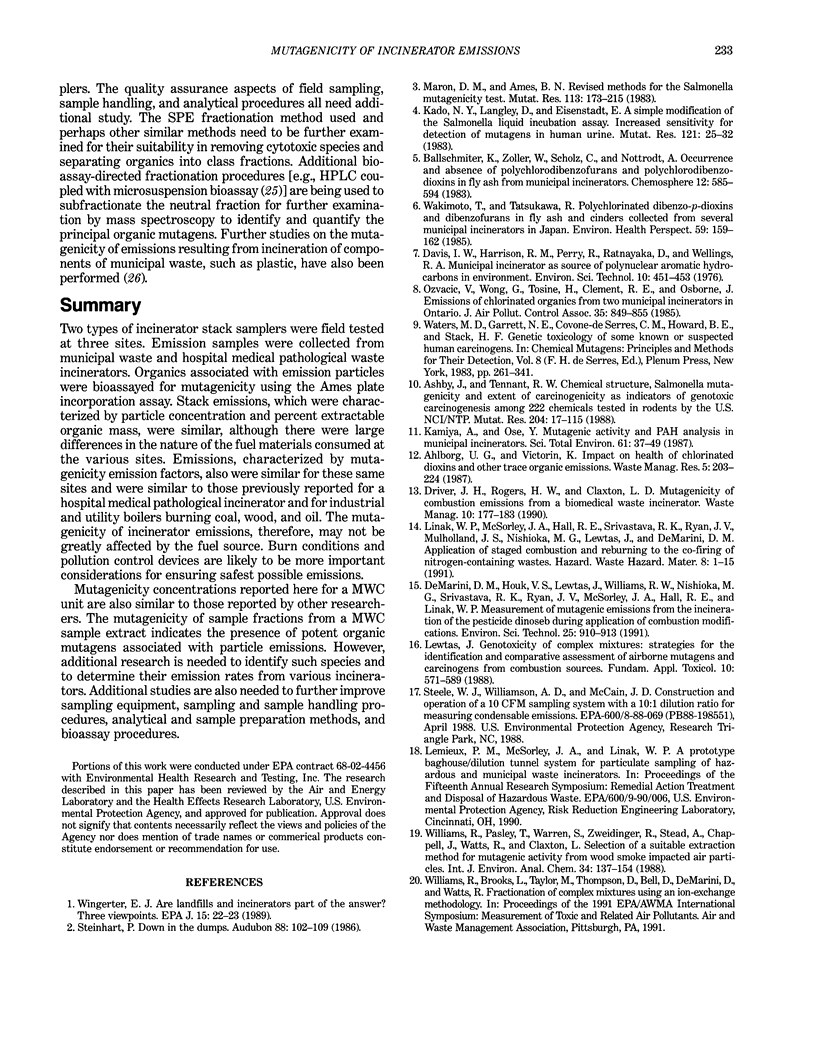Abstract
Incineration is currently being used for disposal of about 10% of the solid waste generated in the United States, and this percentage will likely increase as land disposal declines. Siting new incinerators, however, is often controversial because of concerns related to the possibility of adverse health effects and environmental contamination from long-term exposure to stack emissions. Specific concerns relate to the adequacies of a) stack emission testing protocols, b) existing regulations, and c) compliance monitoring and enforcement of regulations. U.S. Environmental Protection Agency laboratories are cooperatively conducting research aimed at developing new testing equipment and procedures that will allow a more comprehensive assessment of the complex mixture of organics that is present in stack emissions. These efforts are directed specifically toward developing source testing equipment and procedures, analytical procedures, and bioassay procedures. The objectives of this study were to field test two types of high-volume source dilution samplers, collect stack samples for use in developing analytical and mutagenicity bioassay procedures, and determine mutagenicity of organics associated with emission particles from two municipal waste combustors and a hospital waste combustor. Data are presented for particle concentrations and emission rates, extractable organic concentrations and emission rates, and Salmonella (Ames) mutagenic potency and emission rates. The mutagenic emission rates and emission factors are compared to other incinerators and combustion sources.
Full text
PDF







Selected References
These references are in PubMed. This may not be the complete list of references from this article.
- Ashby J., Tennant R. W. Chemical structure, Salmonella mutagenicity and extent of carcinogenicity as indicators of genotoxic carcinogenesis among 222 chemicals tested in rodents by the U.S. NCI/NTP. Mutat Res. 1988 Jan;204(1):17–115. doi: 10.1016/0165-1218(88)90114-0. [DOI] [PubMed] [Google Scholar]
- Bell D. A., Levine J. G., DeMarini D. M. DNA sequence analysis of revertants of the hisD3052 allele of Salmonella typhimurium TA98 using the polymerase chain reaction and direct sequencing: application to 1-nitropyrene-induced revertants. Mutat Res. 1991 Feb;252(1):35–44. doi: 10.1016/0165-1161(91)90249-8. [DOI] [PubMed] [Google Scholar]
- Kado N. Y., Langley D., Eisenstadt E. A simple modification of the Salmonella liquid-incubation assay. Increased sensitivity for detecting mutagens in human urine. Mutat Res. 1983 Jul;121(1):25–32. doi: 10.1016/0165-7992(83)90082-9. [DOI] [PubMed] [Google Scholar]
- Lewtas J. Genotoxicity of complex mixtures: strategies for the identification and comparative assessment of airborne mutagens and carcinogens from combustion sources. Fundam Appl Toxicol. 1988 May;10(4):571–589. doi: 10.1016/0272-0590(88)90184-4. [DOI] [PubMed] [Google Scholar]
- Löfroth G., Lazaridis G., Rudling L. Mutagenicity assay of emission extracts from wood stoves: comparison with other emission parameters. Sci Total Environ. 1986 Dec 31;58(3):199–208. doi: 10.1016/0048-9697(86)90199-3. [DOI] [PubMed] [Google Scholar]
- Maron D. M., Ames B. N. Revised methods for the Salmonella mutagenicity test. Mutat Res. 1983 May;113(3-4):173–215. doi: 10.1016/0165-1161(83)90010-9. [DOI] [PubMed] [Google Scholar]
- Ozvacic V., Wong G., Tosine H., Clement R. E., Osborne J. Emissions of chlorinated organics from two municipal incinerators in Ontario. J Air Pollut Control Assoc. 1985 Aug;35(8):849–856. doi: 10.1080/00022470.1985.10465967. [DOI] [PubMed] [Google Scholar]
- Wakimoto T., Tatsukawa R. Polychlorinated dibenzo-p-dioxins and dibenzofurans in fly ash and cinders collected from several municipal incinerators in Japan. Environ Health Perspect. 1985 Feb;59:159–162. doi: 10.1289/ehp.59-1568091. [DOI] [PMC free article] [PubMed] [Google Scholar]


